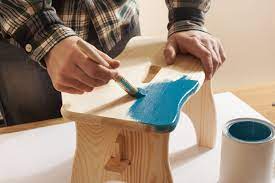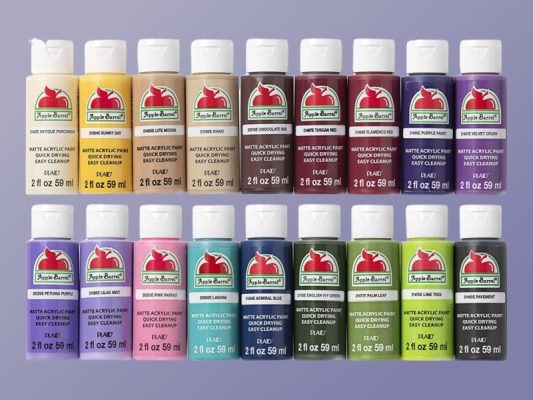When choosing paint for wood crafts, it’s essential to select a good-quality option that suits your project’s needs. For outdoor projects, consider waterproof acrylic paint or craft paint specifically formulated for outdoor use, ensuring durability. Acrylic paint is versatile and suitable for various wood crafts, while latex paint offers a different texture.
Ensure proper preparation, like applying primer or varnish, for optimal results, especially when painting furniture crafts or stenciling on wood.
Best Paint for Wood Crafts
When it comes to enhancing your wood crafts, choosing the right paint is crucial. The best paint for wood crafts varies depending on your project’s needs and preferences. Acrylic paint for wood crafts is popular for its versatility and vibrant colors.
Additionally, consider waterproof paint for wood crafts if your project will be exposed to moisture. Explore spray paint for wood crafts for a quick and efficient application process.

The Best Paint for Wood Crafts If you are looking to paint your wood crafts, the good news is that there are dozens of options available. From spray paints to brush-on latex and oil-based paints, there is something for every woodworking project. But which paint should you use? Let’s take a closer look at the best paints for wood crafts so you can make the right decision.
1. Latex Paint
Latex paint is a great choice if you’re looking for an inexpensive option that dries quickly and is easy to clean with soap and water. It also offers a great range of colors, although it doesn’t adhere as well to unfinished or textured surfaces as other types of paint do.

Latex paint has a soft, matte finish that is perfect for a variety of projects, from furniture refinishing to decorative pieces.
2. Spray Paint

Spray paint is an ideal choice when painting large surfaces or detailed areas like carvings and moldings. This type of paint comes in a wide array of colors, but it tends to wear off more quickly than some other types of paint. It also isn’t suitable for very thin pieces since the spray can clog up fine details and cause runs or sags in the paint job.
3. Oil-Based Paints
Oil-based paints are thicker than latex and generally provide better coverage when painting large surfaces or intricate details. They also dry slower than latex paints and are more resistant to scratches and stains, making them perfect for furniture refinishing projects. However, they tend to be more expensive than latex paints and require special tools such as brushes, rollers, and solvents for cleanup.

When choosing the best paint for your wood craft projects, it all comes down to personal preference as well as what type of project you’re working on and how much time you have available to complete it. Latex paints offer quick drying times with easy cleanup while spray paints are great for large surfaces or intricate details.
Oil-based paints offer excellent coverage but require special tools and materials for cleanup after the painting is finished. Ultimately, the best choice depends on what type of project you’re working on and how much time you have available. No matter which option you choose though, your wood craft projects will look beautiful!
What is the Best Paint for Wood Crafts?
For the best results when painting wood crafts, it is important to use a high-quality paint that is specially formulated for painting wood. For whole surface coverage, an oil-based enamel will provide superior adhesion and durability while also producing a long-lasting glossy finish. However, if you are looking for a matte finish with less sheen, then an alkyd primer combined with acrylic latex paint is the recommended option.

When selecting your paints and primers make sure they offer superior adhesion and durability on porous materials like wood. Also look for paints that are mold-resistant, mildew-resistant, fade-resistant, and water-based so you get easy application as well as easy cleanup after use. Additionally, using multiple coats of varnish will help protect your finished project from wear and tear over time while at the same time enhancing its visual appeal.
The most important factor when working on any kind of craft project is safety. To avoid improper handling of hazardous material always follow the manufacturer’s instructions thoroughly before undertaking any kind of painting activity involving woodwork or other crafting items. Wear protective gear such as gloves and masks to ensure maximum safety during the process and only apply paint in well-ventilated areas free from direct sunlight exposure to prevent unnecessary fading due to UV rays exposure.
When it comes to painting wood crafts, the best solution depends on your specific project and desired results. There is no one-size-fits-all answer as each type of paint has its own set of properties. However, there are a few basic points to consider when selecting the right paint for your project.
First, consider the surface you plan to paint: will it be exposed to moisture or extreme temperatures? If so, you’ll want to select an outdoor-grade acrylic or latex paint with a protective top coat that won’t break down in high temperatures and humid conditions. Oil-based paints provide great protection against moisture and resist heat better than water-based paints but take much longer to dry and have higher levels of volatile organic compounds (VOCs). Latex paints provide more even coverage than oil-based ones but do not last as long in exterior applications without proper top coating.
For interior projects where less durability is required, you may use either latex or oil-based paint—the latter being applicable if you like working with its smoother film finish that can be buffed for an even shinier look after it’s dried up completely. Conversely, if your goal is rustic décor with low maintenance requirements then chalk paint could also be an option due to its matte finish look; just make sure it’s suitable for wooden surfaces before buying any cans!
In terms of color selection, stains tend to make wood grain stand out more whereas traditional oils can help bring out subtle nuances in color; latex paints usually offer the widest range of colors though their opacity cannot compare with pigmented lacquers which give off vivid hues that draw attention immediately when applied correctly over bare wood surfaces—provided they receive enough curing time between coats beforehand! The choice ultimately boils down to how bold/subtle nature you prefer and what will fit into your overall design scheme – almond whites offer crispness whereas gray tones create warmth/coziness depending on their shade level etcetera.
Conclusion
Finally, if all else fails then use metal craft sprayers because they deliver uniform atomized particles which makes intricate designs quite easily achievable plus they dry faster than most other options available today; giving a perfect finish within minutes after completion! Ultimately no matter what type of finish you go for just remember one thing: always use quality brushes/rollers and take time while sanding & priming before making the application—this way nothing can stop you from achieving perfect painted results every single time!